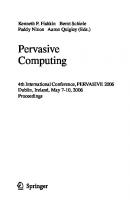Pervasive Computing: First International Conference, Pervasive 2002, Zürich, Switzerland, August 26-28, 2002. Proceedings (Lecture Notes in Computer Science, 2414) 3540440607, 9783540440604
This volume contains the proceedings of Pervasive 2002, the ?rst in a series of international conferences on Pervasive C
136 5 7MB
English Pages 316 [310] Year 2002
Table of contents :
Pervasive Computing
Preface
Organization
Table of Contents
The SAHARA Model for Service Composition across Multiple Providers
Introduction
Technical Issues
Service Composition Models
Service Composition: A Layered Reference Model
Mechanisms for Service Composition
Measurement-Based Adaptation
Utility-Based Resource Allocation Mechanisms
Trust Management and Verification of Service/Usage
Policy Management
Interoperability through Transformation
Service Deployment
Related Work
Conclusions
References
Ubiquitous Computing in the Automotive Domain (Abstract)
Building Applications for Ubiquitous Computing Environments
Introduction
Motivation
Application Framework
Application Data
Infrastructure
Presentation Manager
Application Design and Implementation
Using the Application
Related Work
Conclusions and Future Work
References
Systems Support for Ubiquitous Computing: A Case Study of Two Implementations of Labscape
Introduction
The Application Requirements
System Support for Ubiquitous Computing
Comparison of Two Implementations
Evaluation
Ubiquitous Accessibility
Flexible Control of I/O Resources
Robustness
A User Scenario
Status and Conclusions
References
On the Gap between Vision and Feasibility
Introduction
What Do We Mean by Approximation?
Why Do Some Scenarios Seem Like Science Fiction?
Pervasive Computing and Context Awareness
Summary and Conclusions
Future Research
References
The Fastap Keypad and Pervasive Computing
Overview
Impact of Input
Telephone History
Fastap Technology
Operation
New Paradigm
Quantitative Analysis
Key Density ΠTheory
Key Density ΠPractice
Key Size
Summary
Qualitative Analysis
Discussion.
Conclusion
References
Going Back to School: Putting a Pervasive Environment into the Real World
Introduction
Developing Storytelling Environments
The Original Room-Scale System
Moving into the Classroom Environment
Competing for Space in the School
Finding Time
Configuring and Maintaining the System
The Final Room-Scale System
Problems with the Original System
Supporting a Localized Dynamic Infrastructure
Implementation
Sample Use
Discussion
Conclusions
References
Pervasive Web Access via Public Communication Walls
Introduction
The WebWall Framework Architecture
Visual Components and Styles
Scenario: Posting a Note to a WebWall via SMS
Related Work
Conlusions
References
Efficient Object Identification with Passive RFID Tags
Introduction
The I-Code RFID System
Tag Memory
Programming Interface
Framed Slotted Aloha Medium Access
Mathematical Preliminaries
Occupancy Problems
Tag Reading as a Markov Process
Parameter Estimation
Identification Performance
Full Tag Set Identification
Dynamic Slot Allocation
Adaptive Tag Reading
Choosing an Optimal Frame Size
Continuous and Static Tag Reading
A Procedure for Static Tag Set Identification
Experimental Results
Related Work
Conclusions
References
The Untrusted Computer Problem and Camera-Based Authentication
Introduction
Related Work
Model
The Device
Relaying Device
Monitoring Device
Camera Based Solution
Pixel Mapping
Optical Character Recognition
Possible Extensions
Concluding Remarks
References
SoapBox: A Platform for Ubiquitous Computing Research and Applications
Introduction
Related Work
SoapBox Version 1.0
Implementation
SoapBox Applications
Two Player Maze
Personal Area Network for Recording User Activity
Gesture Recognition
Short Range Wireless Link
Conclusion and Further Work
Scenarios for New Applications
References
Pushpin Computing System Overview: A Platform for Distributed, Embedded, Ubiquitous Sensor Networks
Introduction
Related Work
Design Points
Hardware
Power Module
Communication Module
Processing Module
Expansion Module
Programming Model
Process Fragments
Bertha: The Pushpin OS
Pushpin IDE
Security
Example: Network Gradient
Conclusions & Future Work
References
Making Sensor Networks Practical with Robots
Introduction
Practical Issues in Wireless Sensor Networks
Context Aware Deployment of Sensors
Continuous Calibration of Sensors
Renewable Energy Provided by Mobile Service Robots
PlantCare
The Sensors
The Robot
The Software
A Simple Experiment
Experiment Setup
Experiment Results
Conclusions and Future Work
References
Modeling Context Information in Pervasive Computing Systems
Motivation
Defining Context
Case Study: Context-Aware Communication
Characteristics of Context Information
Context Modeling and Management for Pervasive Systems: Requirements
Related Work
Modeling Context Information
Core Modeling Concepts
Classifying Associations
Structural Constraints on Associations
Modeling Dependencies
Modeling Context Quality
Concluding Remarks
References
A Model for Software Configuration in Ubiquitous Computing Environments
Introduction
The COCA Model
{Resources}futurelet next and {Context}futurelet next
Classifiers and Concepts
Ontologies and Relations
{Actions}futurelet next
Ubiquitous Computingfuturelet next Demonstrator
Conclusion
References
INS/Twine: A Scalable Peer-to-Peer Architecture for Intentional Resource Discovery
Introduction
INS/Twine System Architecture
Resource Descriptions
Architecture Overview
Resolver Layer
StrandMapper Layer
KeyRouter Layer
State Management
Evaluation
Splitting Descriptions into Strands
Distributing Data among Resolvers
Resolving Queries
Conclusion
References
Location Estimation Indoors by Means of Small Computing Power Devices, Accelerometers, Magnetic Sensors, and Map Knowledge
Introduction
System Description
Step Detection and Activity Recognition
Experimental Results
System Performance on Level Ground
System Performance with Upstairs and Downstairs Walking Included
System Performance in the Presence of Strong Magnetic Field Distortions
Conclusions and Future Work
References
Estimating the Benefit of Location-Awareness for Mobile Data Management Mechanisms
Introduction
Related Work
Preliminaries
Herfindahl Coefficient
Gini Coefficient
Comparison
Location-Dependency
Definitions
Discussion
Focus
Definitions
Discussion
Evaluation
Location-Dependency
Focus
An Example Application
Conclusion
References
iCAMS: A Mobile Communication Tool Using Location and Schedule Information
Introduction
System
Problems with Prior System: CAMS
ICAMS
User Studies
Discussion
References
Browser State Repository Service
Introduction
Motivation Scenario
Client-Based Approach vs. Server-Based Approach
Related Work
Design
Implementation
Document Object State
Tracking Frames
Cookie State
Script State
History State
Performance
Conclusion and Future Work
References
Annotation by Transformation for the Automatic Generation of Content Customization Metadata
Introduction
A Perspective on Device Independent Authoring
Annotation-Based Content Adaptation
Annotation Framework
Annotation-Based HTML-Page Clipping
Automatic Generation of Annotation
Annotation by Assertion
Annotation by Transformation
Metadata Generation Procedure
Concluding Remarks
References
SCAN: A Dynamic, Scalable, and Efficient Content Distribution Network
Introduction
Related Work
Distributed Object Location and Routing
SCAN Replica Management Algorithms
Goals for Replica Placement
Dynamic Placement
Soft State Tree Management
Evaluation
Experimental Setup
Results for Synthetic Workload
Results for Web Traces Workload
Discussion
Conclusions
References
Author Index
Pervasive Computing
Preface
Organization
Table of Contents
The SAHARA Model for Service Composition across Multiple Providers
Introduction
Technical Issues
Service Composition Models
Service Composition: A Layered Reference Model
Mechanisms for Service Composition
Measurement-Based Adaptation
Utility-Based Resource Allocation Mechanisms
Trust Management and Verification of Service/Usage
Policy Management
Interoperability through Transformation
Service Deployment
Related Work
Conclusions
References
Ubiquitous Computing in the Automotive Domain (Abstract)
Building Applications for Ubiquitous Computing Environments
Introduction
Motivation
Application Framework
Application Data
Infrastructure
Presentation Manager
Application Design and Implementation
Using the Application
Related Work
Conclusions and Future Work
References
Systems Support for Ubiquitous Computing: A Case Study of Two Implementations of Labscape
Introduction
The Application Requirements
System Support for Ubiquitous Computing
Comparison of Two Implementations
Evaluation
Ubiquitous Accessibility
Flexible Control of I/O Resources
Robustness
A User Scenario
Status and Conclusions
References
On the Gap between Vision and Feasibility
Introduction
What Do We Mean by Approximation?
Why Do Some Scenarios Seem Like Science Fiction?
Pervasive Computing and Context Awareness
Summary and Conclusions
Future Research
References
The Fastap Keypad and Pervasive Computing
Overview
Impact of Input
Telephone History
Fastap Technology
Operation
New Paradigm
Quantitative Analysis
Key Density ΠTheory
Key Density ΠPractice
Key Size
Summary
Qualitative Analysis
Discussion.
Conclusion
References
Going Back to School: Putting a Pervasive Environment into the Real World
Introduction
Developing Storytelling Environments
The Original Room-Scale System
Moving into the Classroom Environment
Competing for Space in the School
Finding Time
Configuring and Maintaining the System
The Final Room-Scale System
Problems with the Original System
Supporting a Localized Dynamic Infrastructure
Implementation
Sample Use
Discussion
Conclusions
References
Pervasive Web Access via Public Communication Walls
Introduction
The WebWall Framework Architecture
Visual Components and Styles
Scenario: Posting a Note to a WebWall via SMS
Related Work
Conlusions
References
Efficient Object Identification with Passive RFID Tags
Introduction
The I-Code RFID System
Tag Memory
Programming Interface
Framed Slotted Aloha Medium Access
Mathematical Preliminaries
Occupancy Problems
Tag Reading as a Markov Process
Parameter Estimation
Identification Performance
Full Tag Set Identification
Dynamic Slot Allocation
Adaptive Tag Reading
Choosing an Optimal Frame Size
Continuous and Static Tag Reading
A Procedure for Static Tag Set Identification
Experimental Results
Related Work
Conclusions
References
The Untrusted Computer Problem and Camera-Based Authentication
Introduction
Related Work
Model
The Device
Relaying Device
Monitoring Device
Camera Based Solution
Pixel Mapping
Optical Character Recognition
Possible Extensions
Concluding Remarks
References
SoapBox: A Platform for Ubiquitous Computing Research and Applications
Introduction
Related Work
SoapBox Version 1.0
Implementation
SoapBox Applications
Two Player Maze
Personal Area Network for Recording User Activity
Gesture Recognition
Short Range Wireless Link
Conclusion and Further Work
Scenarios for New Applications
References
Pushpin Computing System Overview: A Platform for Distributed, Embedded, Ubiquitous Sensor Networks
Introduction
Related Work
Design Points
Hardware
Power Module
Communication Module
Processing Module
Expansion Module
Programming Model
Process Fragments
Bertha: The Pushpin OS
Pushpin IDE
Security
Example: Network Gradient
Conclusions & Future Work
References
Making Sensor Networks Practical with Robots
Introduction
Practical Issues in Wireless Sensor Networks
Context Aware Deployment of Sensors
Continuous Calibration of Sensors
Renewable Energy Provided by Mobile Service Robots
PlantCare
The Sensors
The Robot
The Software
A Simple Experiment
Experiment Setup
Experiment Results
Conclusions and Future Work
References
Modeling Context Information in Pervasive Computing Systems
Motivation
Defining Context
Case Study: Context-Aware Communication
Characteristics of Context Information
Context Modeling and Management for Pervasive Systems: Requirements
Related Work
Modeling Context Information
Core Modeling Concepts
Classifying Associations
Structural Constraints on Associations
Modeling Dependencies
Modeling Context Quality
Concluding Remarks
References
A Model for Software Configuration in Ubiquitous Computing Environments
Introduction
The COCA Model
{Resources}futurelet next and {Context}futurelet next
Classifiers and Concepts
Ontologies and Relations
{Actions}futurelet next
Ubiquitous Computingfuturelet next Demonstrator
Conclusion
References
INS/Twine: A Scalable Peer-to-Peer Architecture for Intentional Resource Discovery
Introduction
INS/Twine System Architecture
Resource Descriptions
Architecture Overview
Resolver Layer
StrandMapper Layer
KeyRouter Layer
State Management
Evaluation
Splitting Descriptions into Strands
Distributing Data among Resolvers
Resolving Queries
Conclusion
References
Location Estimation Indoors by Means of Small Computing Power Devices, Accelerometers, Magnetic Sensors, and Map Knowledge
Introduction
System Description
Step Detection and Activity Recognition
Experimental Results
System Performance on Level Ground
System Performance with Upstairs and Downstairs Walking Included
System Performance in the Presence of Strong Magnetic Field Distortions
Conclusions and Future Work
References
Estimating the Benefit of Location-Awareness for Mobile Data Management Mechanisms
Introduction
Related Work
Preliminaries
Herfindahl Coefficient
Gini Coefficient
Comparison
Location-Dependency
Definitions
Discussion
Focus
Definitions
Discussion
Evaluation
Location-Dependency
Focus
An Example Application
Conclusion
References
iCAMS: A Mobile Communication Tool Using Location and Schedule Information
Introduction
System
Problems with Prior System: CAMS
ICAMS
User Studies
Discussion
References
Browser State Repository Service
Introduction
Motivation Scenario
Client-Based Approach vs. Server-Based Approach
Related Work
Design
Implementation
Document Object State
Tracking Frames
Cookie State
Script State
History State
Performance
Conclusion and Future Work
References
Annotation by Transformation for the Automatic Generation of Content Customization Metadata
Introduction
A Perspective on Device Independent Authoring
Annotation-Based Content Adaptation
Annotation Framework
Annotation-Based HTML-Page Clipping
Automatic Generation of Annotation
Annotation by Assertion
Annotation by Transformation
Metadata Generation Procedure
Concluding Remarks
References
SCAN: A Dynamic, Scalable, and Efficient Content Distribution Network
Introduction
Related Work
Distributed Object Location and Routing
SCAN Replica Management Algorithms
Goals for Replica Placement
Dynamic Placement
Soft State Tree Management
Evaluation
Experimental Setup
Results for Synthetic Workload
Results for Web Traces Workload
Discussion
Conclusions
References
Author Index

- Author / Uploaded
- Friedemann Mattern (editor)
- Mahmoud Naghshineh (editor)









